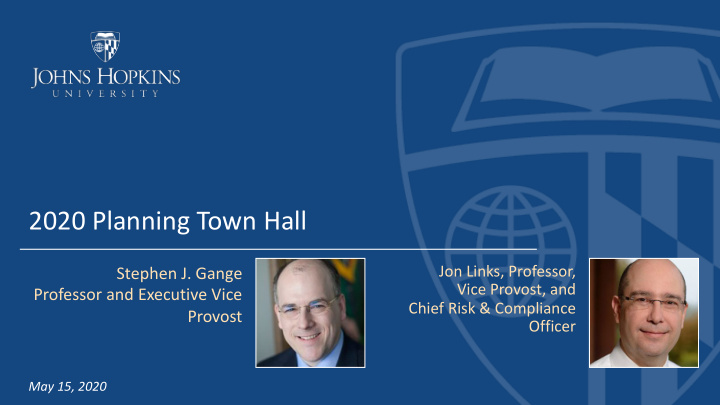



2020 Planning Town Hall Jon Links, Professor, Stephen J. Gange Vice Provost, and Professor and Executive Vice Chief Risk & Compliance Provost Officer May 15, 2020
Maryland Strong Roadmap to Recovery The Roadmap expects that people currently teleworking shall continue to telework for the duration of the State of Emergency. The Roadmap also expects that physical distancing and masking requirements shall continue until the lifting of the State of Emergency Stages Impacted Activities ‘Stay at Home’ March 30 Order: Stay at home except to conduct or participate in essential activities; Gatherings larger than 10 “Stop Signs” requiring the prohibited; Closure of non-essential businesses easing to slow, stop, or even be reversed: Reopening ‘Low Risk’ Activities Beyond lifting the “Stay-Home” Order, other examples of changes that could be implemented in this stage: • Limited attendance outdoor religious gatherings (‘Phase 1’) a. An unexpected increase • Recreational boating, fishing, golf, tennis, hiking, and in hospitalizations or a • Small shops and certain small businesses hunting sustained increase in • Curbside pickup and drop-off for businesses • Car washes cases requiring intensive • Elective medical and dental procedures at • Limited outdoor gym and fitness classes care. ambulatory, outpatient, and medical offices • Outdoor work with appropriate distancing measures b. Indications that • Some personal services Marylanders are disregarding physical Reopening ‘Medium Risk’ Activities Examples of changes that could be implemented in this distancing guidelines. stage: (‘Phase 2’) c. Significant outbreaks of Any businesses that reopen during this community transmission • Raising the cap on social gatherings • Transit schedules begin returning to normal period will need to comply with strict physical (not clusters or outbreaks • Indoor gyms and fitness classes • Indoor religious gatherings in particular nursing distancing and appropriate masking • Childcare centers • Restaurants and bars with restrictions homes or vulnerable requirements. • Elective and outpatient procedures at hospitals communities) where contact tracing cannot establish the route of the Reopening ‘High Risk’ Activities Examples of changes that could be implemented in this stage: spread. (‘Phase 3’) A sustained increase in • Larger social gatherings cases over a period of Requires either a widely available and • High-capacity bars and restaurants five or more days may FDA-approved vaccine or safe and effective • Lessened restrictions on visits to nursing homes and hospitals require the re-imposition therapeutics that can rescue patients with • Entertainment venues of some prior restrictions. significant disease or prevent serious illness in • Larger religious gatherings those most at risk to reach a full return to normal conditions.
JHU Planning Process https://hub.jhu.edu/novel-coronavirus-information/jhu-2020-planning/
https://hub.jhu. edu/novel- coronavirus- information/jhu -2020-planning/ 7
Student Advisory Committee 20 students representing all nine schools will contribute to university efforts to address range of operational challenges related to COVID-19 pandemic 8
Questions? https://hub.jhu.edu/vip/2020-planning-town-hall/ 9
Recommend
More recommend